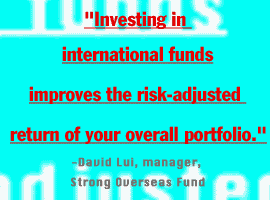|
Taking your 401(k) abroad
|
 |
January 31, 2000: 6:13 a.m. ET
U.S. stocks have been good to investors; overseas funds can be, too
By Staff Writer Jeanne Sahadi
|
NEW YORK (CNNfn) - When you think of the stock market, you probably envision Wall Street, not the financial district in Sydney or Madrid. But if you're investing long term, taking your 401(k) or IRA global will cushion your retirement savings.
For one thing, the bull run in the U.S. market can't last forever. And given the growth potential of many economies abroad, markets overseas will attract more and more capital, experts say.
"The U.S. economy being so big cannot grow as fast as some of the fleet-of-foot economies. For us to grow two percent is much more difficult than for a small country to grow two percent," said David Lui, manager of Strong's Overseas Fund and International Stock Fund.
And even in large countries such as China, "the potential for consumerism is huge," said certified financial planner Joseph Votava, Jr.
Same as it ever was ... not
Sure, you think, but even in a bad year, don't U.S. stocks outperform those in the rest of the world?
In a word, no.

"Investors in the U.S. have a short-term memory," Lui said.
In fact, in dollar terms, the S&P 500 underperformed the major international benchmark, Morgan Stanley's Europe, Australasia and Far East (EAFE) Index, for 10 of the 20 years between 1980 and 1999, according to Global Financial Data. And on an average annual return basis, the EAFE held its own, rising 14.8 percent compared to the S&P's gain of 17.9 percent.
Open yourself to the world
So to protect yourself from Wall Street's inevitable downturns, an international fund can be a good buffer as well as a profit maker.
"Investing in international funds improves the risk-adjusted return of your overall portfolio," Lui said.
The best way for the average investor to gain exposure is through a diversified foreign fund, which invests in a variety of countries but not the United States, said Kunal Kapoor, an analyst with fund-tracker Morningstar.

A world fund, by contrast, invests an average of 37 percent of its assets in the United States, according to Morningstar.
"There are a lot of good companies outside the U.S. and it's good to have exposure to them," Kapoor said.
How big is your risk appetite?
But before you assign any of your 401(k) or IRA money to a foreign fund, figure out how much risk exposure you want.
A fund focusing on developed countries is less risky than one with assets in emerging markets, where political and economic volatility are the rule rather than the exception.
If you are more aggressive, Kapoor suggests putting some of your money in a diversified fund and a smaller amount in an emerging market fund.
You also can invest in funds specific to a sector, country or region. But Kapoor and Lui caution that for most investors it's hard to know where the winners will be, and single-country funds in particular tend to be very volatile.
"It's a long shot," Kapoor said.
Even diversified regional funds pose more risk than a broad foreign selection. Think "Asia crisis."
Although Asia funds enjoyed a strong 1999, thanks to the beginnings of economic recovery in Japan, investors in the average Asia fund received a mere 5.2 percent annual return in the 1990s, according to Morningstar.
Choosing the best fund for you
When deciding where to put your money, Kapoor said you should investigate:
- The fund manager's record;
- The fund's expenses to shareholders; and
- How much exposure the fund has to emerging markets.

Certified financial planner Mark Groesbeck looks for diversified, large-cap foreign funds that deliver steady, long-term performance. Among his top picks:
- EuroPacific Growth (AEPGX)
- Northstar International Value (NIVAX)
- Managers International Equity Fund (MGITX)
Groesbeck steers clients away from emerging markets. But for those willing to take on more risk, he suggests international small cap funds, which outperformed the S&P 500 over the past five years. Two of his top picks are:
- Northstar Int'l Small Cap (NIGRX); and
- Federated Int'l Small Cap (ISCAX)
Sizing up your world pie
No matter how many funds you choose, most experts recommend allocating no more than 10 percent to 20 percent of your overall portfolio to international, because overseas markets can be volatile.
Lui, however, thinks that's too low. If you are under 50 and want your portfolio to be more market-weighted, he said, U.S. stocks should account for 55 percent of your portfolio; international stocks should fill 45 percent.
That's because the U.S. share of the world's total market cap has shrunk during the past 30 years. By the end of 1999, U.S. stocks accounted for only 45 percent of the world's total market cap and 49 percent of the market cap in developed countries, according to Morgan Stanley Capital International.
As you near retirement, however, you should reduce your foreign holdings to 20 percent, Lui said.
Again, your risk tolerance is more important than any expert recommendation. Invest only what makes you comfortable.
U.S. multinationals aren't the same
You may think you already have exposure to world markets because you invest in U.S.-based multinationals like Coke (KO). And to some extent you do.
But that doesn't balance your portfolio, Kapoor said, because when the U.S. market goes down, Coke's stock price is likely to be affected. A fund with assets in European stocks -- such as British beverage firm Allied Domecq, in which Warren Buffet recently invested -- will trade differently than the U.S. market.
Your upside may be limited, too. Buying into U.S. companies with international exposure is "like dipping your toe in the water," Lui said. "You've got to get into the ocean." 
|
|
|
|
|
 |

|

